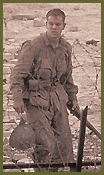Once more unto the breach
Considering the intensity of the picture’s opening sequence, the filmmakers felt that Saving Private Ryan’s ending needed a final skirmish with the Germans in order to balance the film’s dramatic weight. This climactic sequence was set in the fictitious French village of Ramelle. Production designer Tom Sanders built the decimated town in Hatfield, Hertfordshire approximately 45 minutes north of London at the abandoned British Aerospace facility which served as the production’s backlot and English base camp.
"The set Tom Sanders built was amazing," recounts Kaminski. "It was three blocks long and amazingly detailed. As a cinematographer,you have to keep your eye on the smallest details in art direction; when you’re working on such a large-scale film, only you have an idea of what’s going to appear on the negative. Private Ryan is so authentic that the smallest details that one could normally get away with wouldn’t work here. If a group of soldiers are sneaking against a wall and that wall doesn’t look absolutely real, you’re ruining the scene, no matter how good the scene may be.”
Devlin offers, “Tom Sanders did a great job with the coloring and in making the buildings distressed and dark, but the one thing that really made the look of the movie was working with the standby painter, Joe Monks. When we started working in Ramelle, if we felt a building was too bright, and that bringing in flags and cutters for a simple day exterior shot would involve too much work, we’d have Joe come in and make the building darker. We’d give him a 10’ by 40’ wall and in five to 10 minutes he’d be done. That gave the sets much more depth and separation.”
Kaminski found that he used much more lighting in the village than he could in the open fields of Normandy simply because there was the opportunity hide the fixtures and illuminate the interiors of the buildings. The village set was pre-rigged with cables in conduits that ran under the entire town. Rubble was then piled on top of the pipes to hide the distribution boxes. “There’s a shot where Jeremy Davies runs into a building and sees through a window to one side that the Germans are approaching,” submits Devlin. “It was very dark inside the building [compared to the outside], so in order to maintain a certain amount of ambiance and the feeling of light coming in through the window, we used 18Ks with Half Soft Frost to blast through the windows.”
“That was a great shot,” agrees Dubin, who describes how he operated the scene: “We started on the bombed-out street as these German tanks approach. The tank shoots, blows up an emplacement, and the whole frame fills with smoke. Then Jeremy comes running out of the smoke and we follow him across the street as he runs into a burned-out caf�. We run up some stairs after him to the second floor and see out the window that another German tank is advancing and firing toward us. Jeremy runs across the room to another window and we follow him. But as he stops at the window, the camera continues moving, going outside the window to show the view down the street, raking the building. Dolly grip John Flemming and his crew built a platform so that I could walk right out the window and see down the street. I really had to have faith in John, since I was blindly walking out the window and had to be perfectly positioned on that platform!”
War and remembrance
Kaminski and his crew members all feel that Saving Private Ryan was truly a once-in-a-lifetime experience. And though the lighting approach was somewhat simplistic, the resulting imagery is breathtaking. “You don’t always have to provide beautiful lighting,” submits the cinematographer. “I often think ugly lighting and ugly composition tells the story much better than the perfect light. Sometimes a brightly front-lit image may be much more powerful than a silhouette. It all depends on the story. You can’t really preconceive certain visual metaphors, because then the symbol really isn’t a symbol anymore — it’s more of a gimmick. What’s great about cinematography is that you work from your instincts and people later see your work and come up with [an analysis] that you didn’t even realize, but which may make perfect sense.
“I’m learning more and more about lighting,” he concludes. “But you have to be encouraged by the directors. They allow you make the choices that take the movies to a different level. Directors can allow cinematographers to advance to another level, because we all have that capability in us. Some are so scared of taking risks that they won’t allow their cinematographers to try something new. But you can create such powerful and meaningful images by taking chances. I’m talking about things like what Robbie M�ller [BVK, NSC] did on Breaking the Waves. Bob Richardson [ASC], Vittorio Storaro [ASC, AIC] and Malik Sayeed are also very experimental. Newton Thomas Sigel did some great work on Fallen. And what Harris Savides did on The Game was fantastic; I can’t wait to see what he did for [actor/director John Turturro’s upcoming film] Illuminata.
“We’ve all got the ability to do groundbreaking work, and nothing is stopping us from using very experimental techniques in a major Hollywood movie if the subject matter allows it and the director is willing to go there.”
